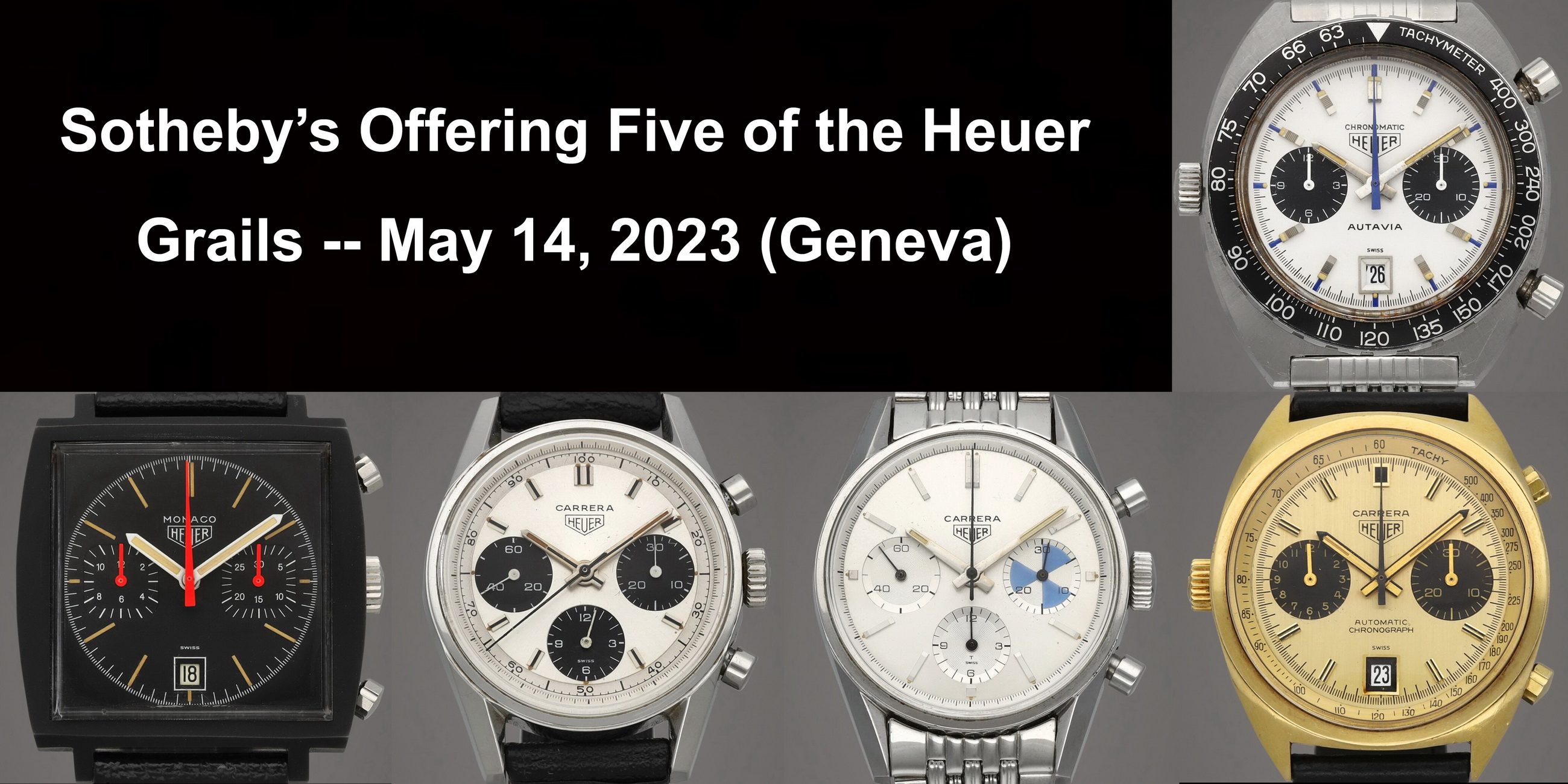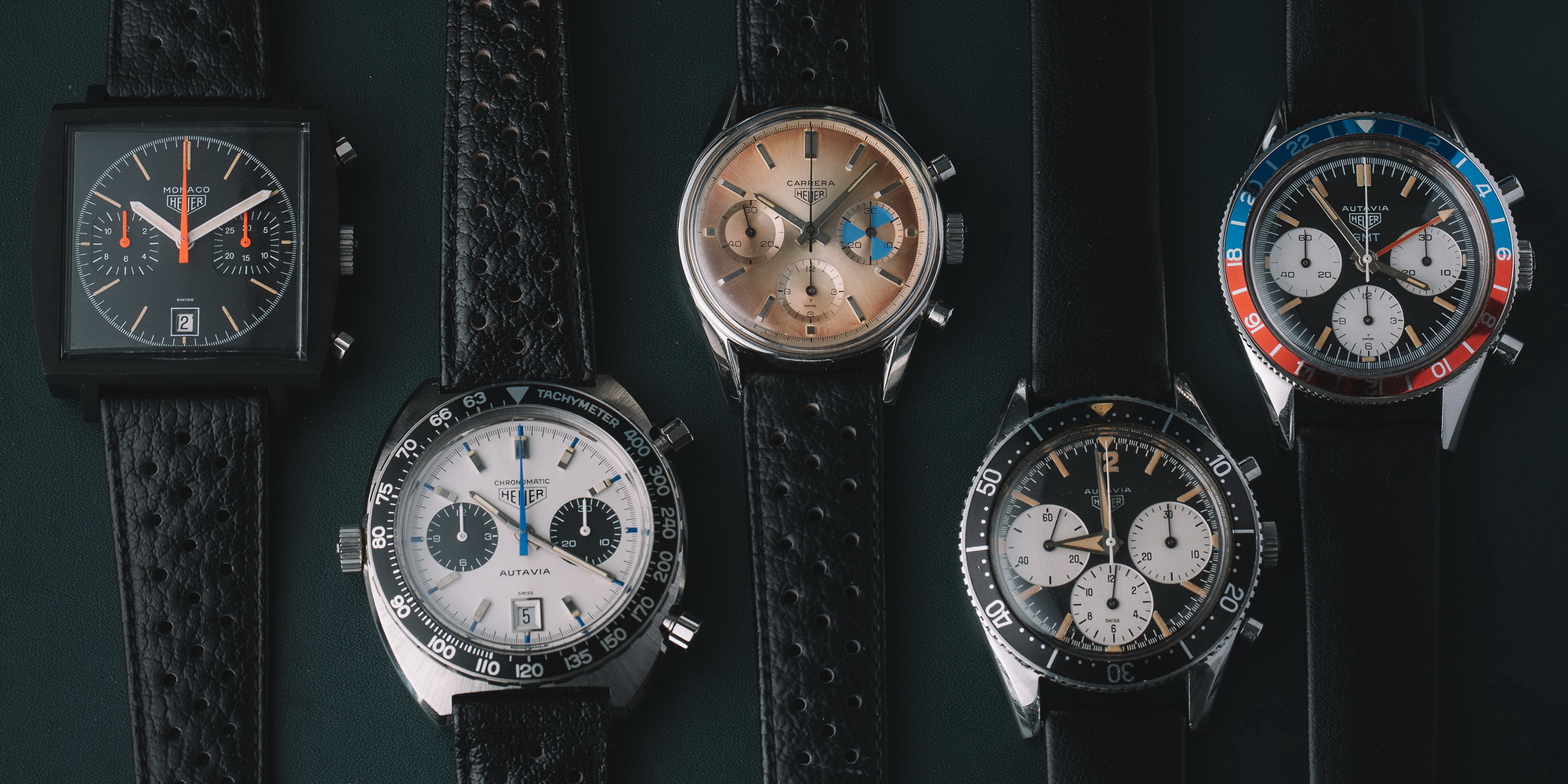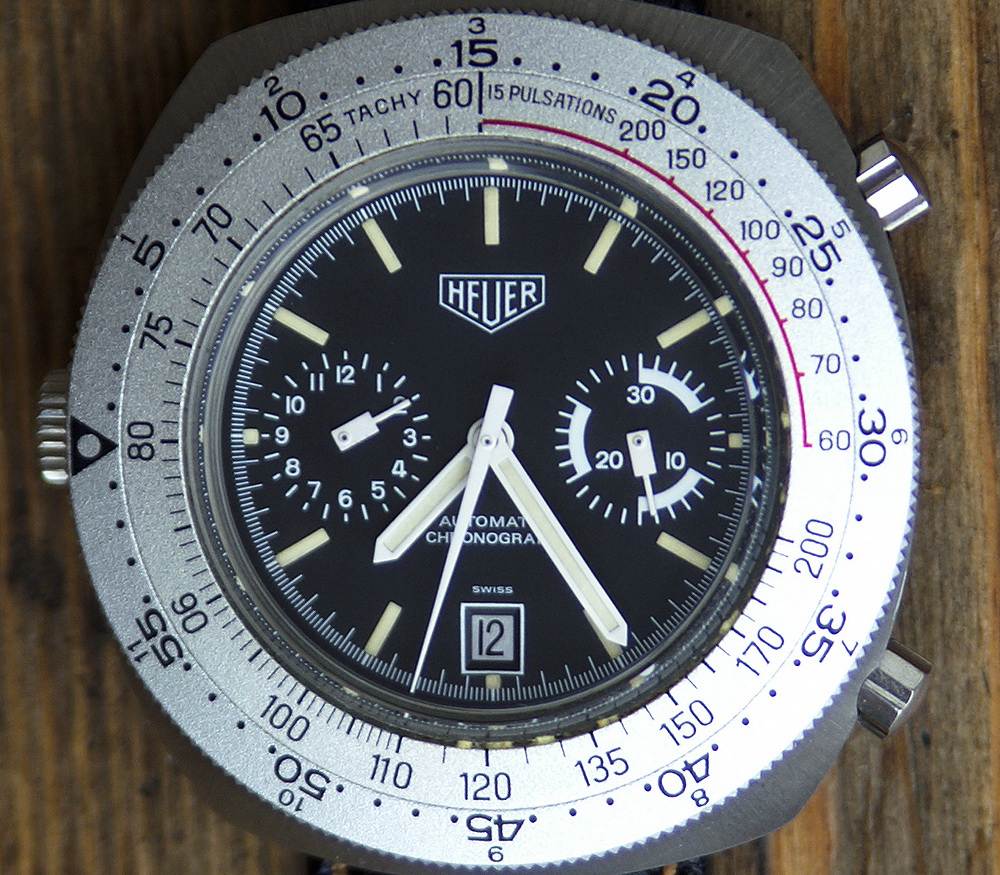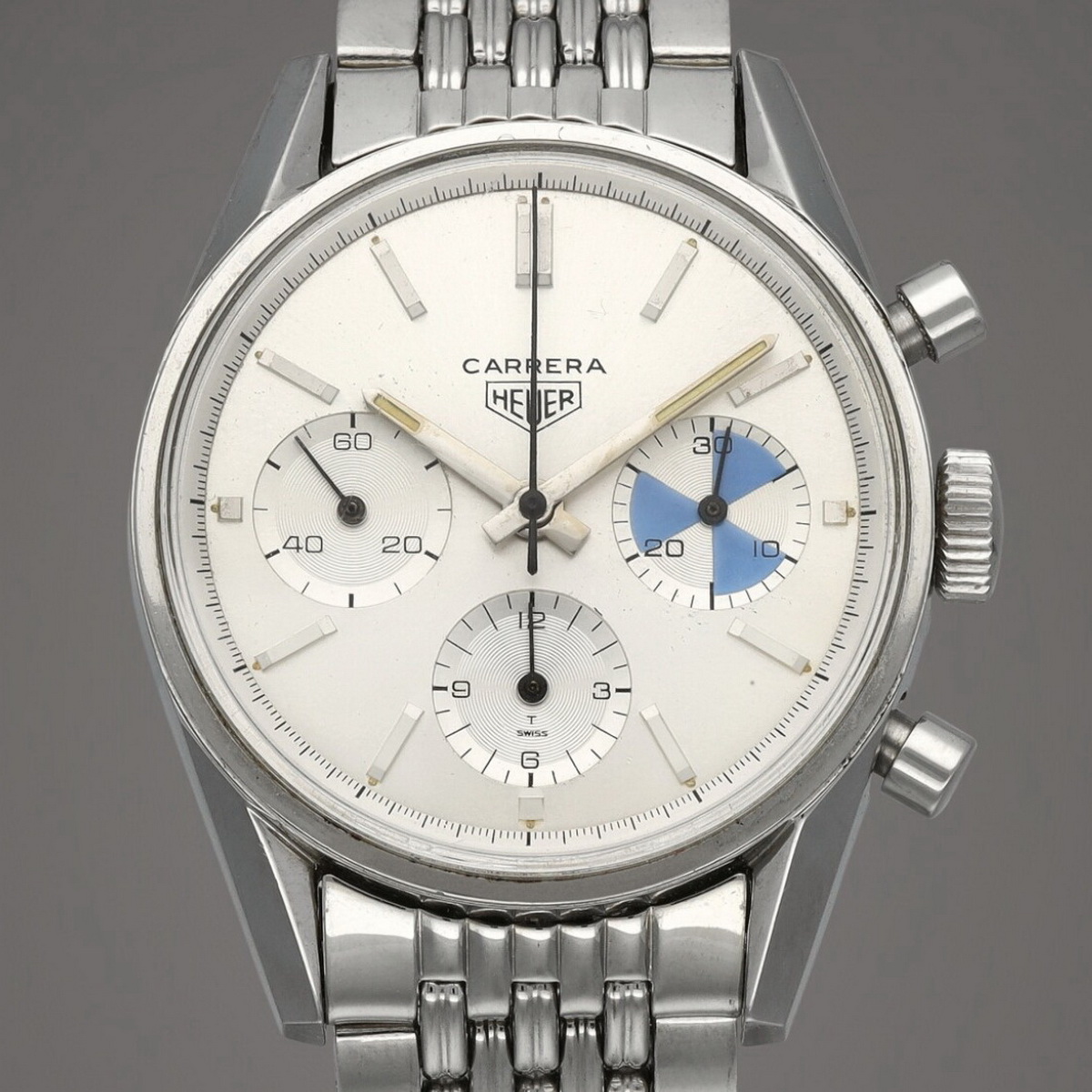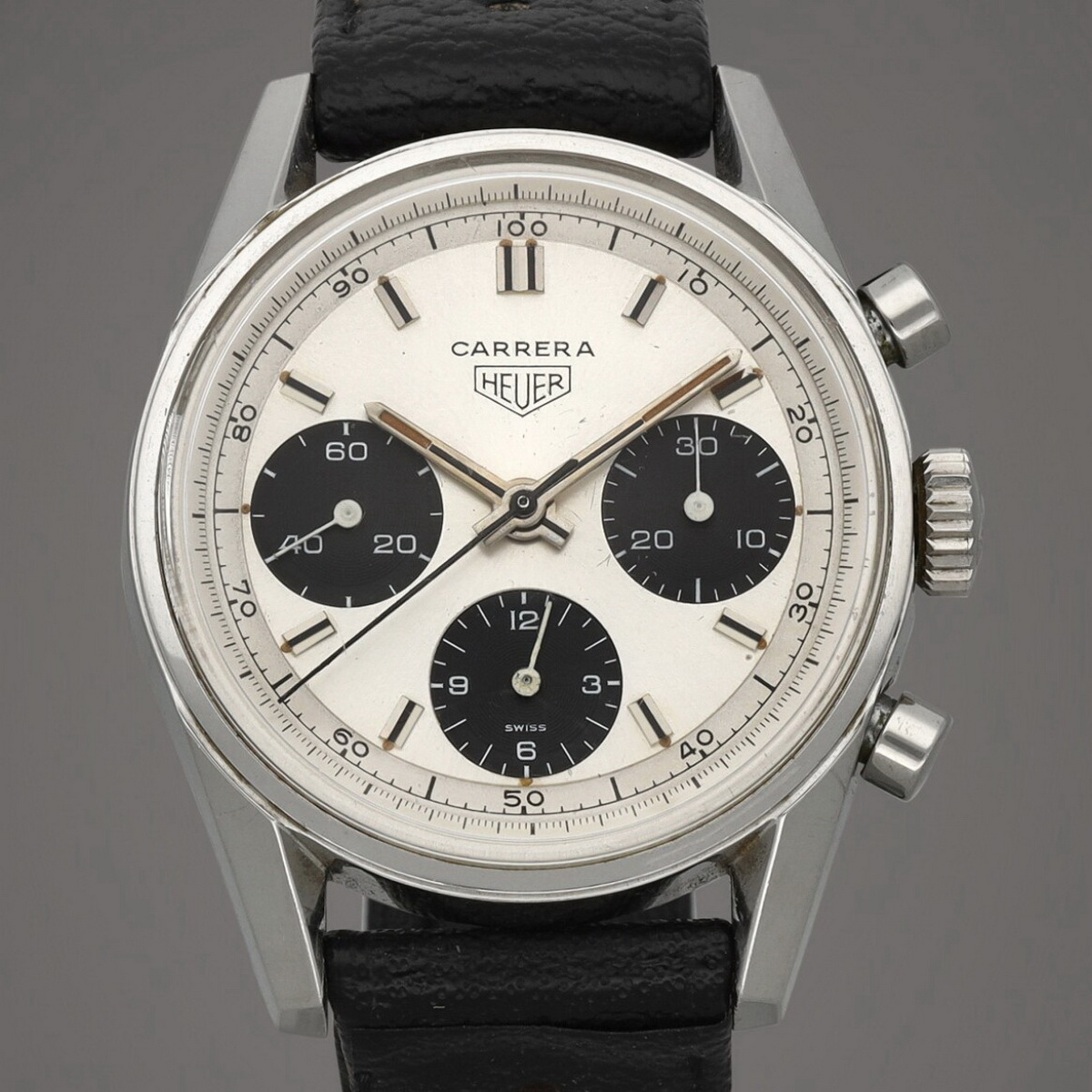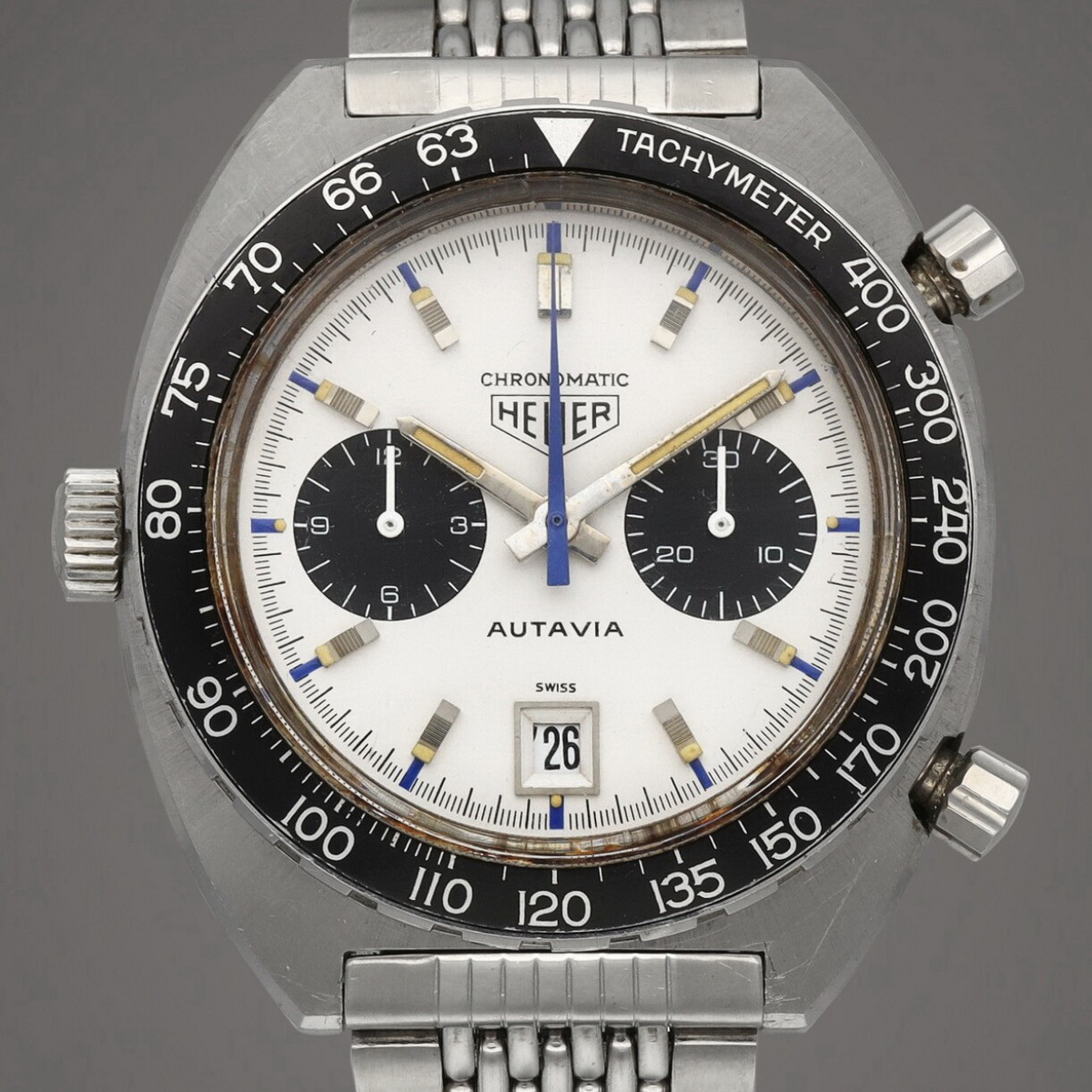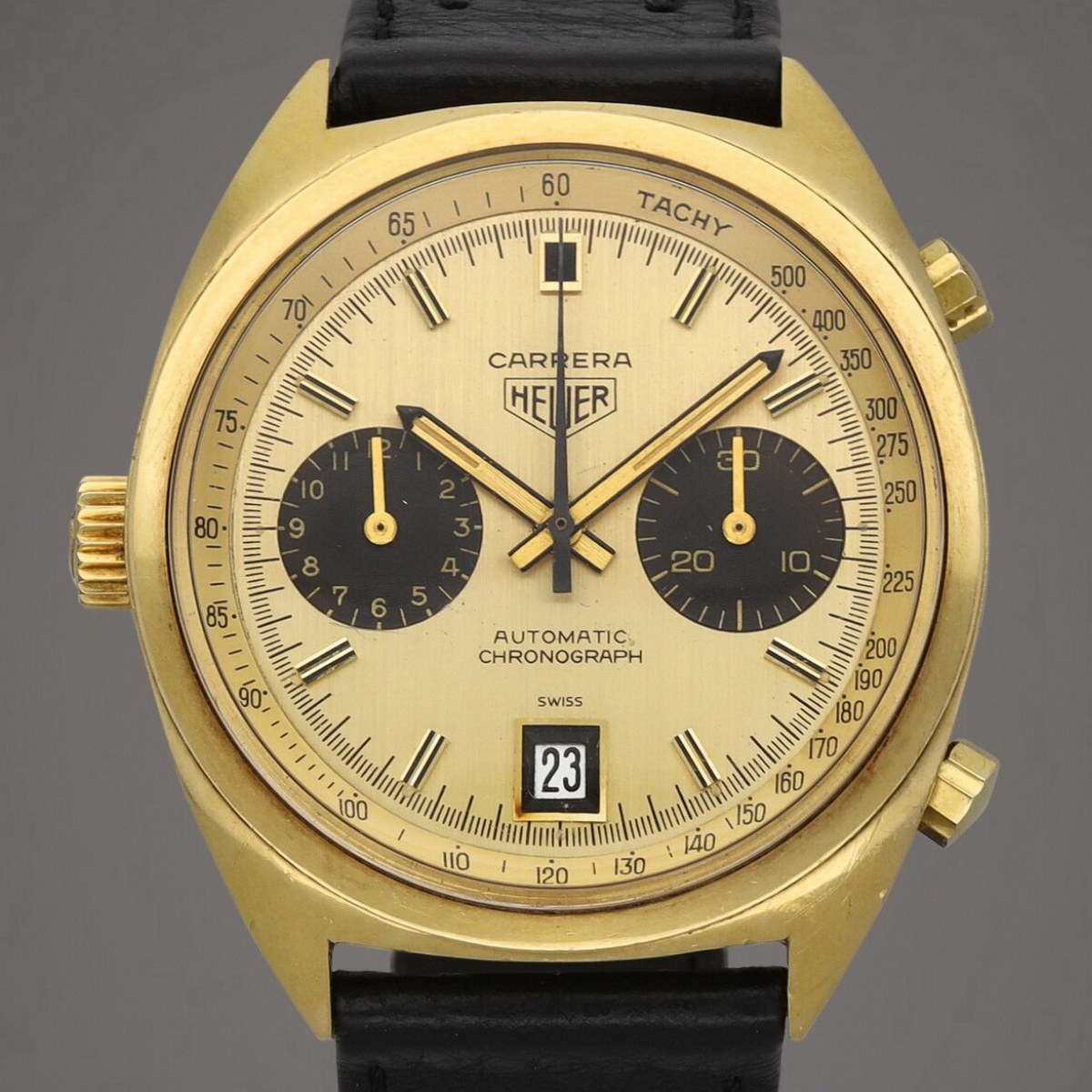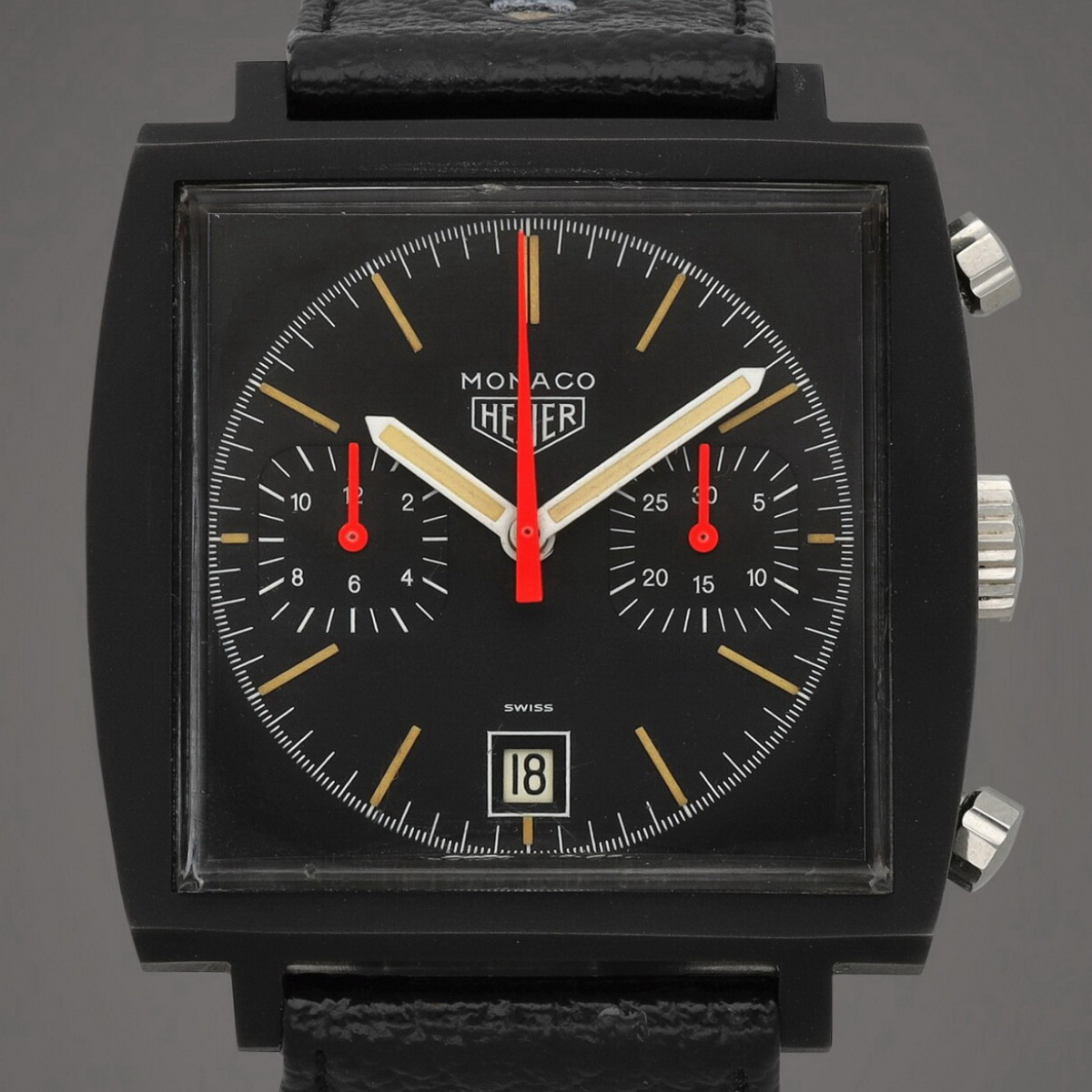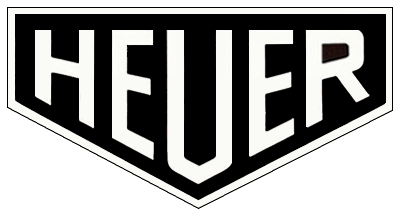Back in May 2020, I published a posting, Vintage Heuer – Chasing the Grails, that offered a definition of the “grail watch”, at least for purposes of the community of vintage Heuer collectors. While any collector may have their own personal “grail” watches, I suggested that from the perspective of the community, a vintage Heuer chronograph is considered a “grail”, if it meets the following three criteria:
First, the model must be extremely rare. Although some of my grails are slightly more abundant, over the course of a year, the diligent watch hunter can expect to have only one or two chances to purchase a particular grail watch. In some years there may be three or four in the market and in other years there may be none, but for most of the grails the reasonable expectation is to see a couple of samples offered for sale. Compared with the availability of the “grails” for other popular brands, the rare Heuer chronographs really are rare.
Second, the watch must have a strong, broad following in the community. This criterion prevents the “oddball” watch from achieving grail status. We gave the example of the Heuer Calculator Reference 11633 chronograph, with the MH / pulsations bezels, rather than the usual slide rule bezels. Yes, this model is rare, but it is hardly coveted by a broad range of collectors in the community. When a true “grail” is listed for sale, there will be a buzz in the vintage Heuer community, as collectors discuss the watch and stake their “dibs” claims.
Third, the watch must be attainable by the enthusiastic collector. This criterion was designed to exclude the extremely rare watch from the list. Visualize the Autavia Reference 2446C with a silver/white dial or the Bundeswehr chronograph powered by the Calibre 12 movement. Our rule of thumb was that a watch could be included as a “grail” only if the diligent collector could reasonably be expected to find one offered for sale during a year or two of searching. The “unattainable” ones do not come along this often.

Based on these three criteria, in May 2020 I presented my list of the 16 “Grails” of the vintage Heuer world:
The List — 16 Grails of the Vintage Heuer World (May 2020)
- Three Register, Black Chronograph, Waterproof; Ref 2447 N (1940s / 50s)
- Triple Calendar Chronograph, Waterproof – Ref 2547 (1940s / 50s)
- The “Big Subs” Autavias, Ref 2446 or Ref 3646 (1962)
- Abercrombie & Fitch Seafarer, in Carrera Case, Ref 2447 (1965)
- ”Yachting” Carrera — Ref 2447 (1964)
- Three Register, Black Tachymeter Carrera – Ref 2447 NT (1965)
- The Chronographs with Racing Logos (1960s/70s)
- The “Skipperrera” — Ref 7754 (1968)
- Autavia GMT, Screw-back case — Ref 2446 (1968)
- Camaro 18 Karat Gold – Ref 7228 (1968)
- Carrera, Three Register Panda – Ref 2447 SN (1968)
- The Chronomatics — Autavia, Carrera or Monaco (1969)
- 18 Karat Gold Automatic Carrera – Ref 1158 (1969 to 1985)
- ”Exotic” Autavia, Cal 15 — Ref 1563 (1972)
- “Yachting Carrera”, Ref. 1153 BN (1974)
- Monaco in Black-Coated Case — Ref 74033N (the “Dark Lord”) (1975)
Have a look at the Chasing the Grails posting for the details and images of all these watches.
The Good News for Grail Hunters
The good news for those who may be in search of the vintage Heuer Grails is that Sotheby’s will be offering five of these 16 chronographs, in its Geneva auction “Important Watches”, this coming Sunday, May 14, 2023. In this posting, we provide some background on each of these five watches. The online catalog for this auction is HERE.
It is also notable that these are the only five Heuer chronographs the Sotheby’s is including in this auction. So no concerns about filler or the more common watches being used to fill out the catalog. If we judge a watch by the company it keeps, all five of the Heuer chronographs being offered by Sotheby’s are top-rated.
Carrera “Yachting”, Ref 2447 (circa 1965) — Lot 3
Introduced in 1963, the first execution of the Carrera is considered one of the purest examples of chronograph design. The waterproof case was designed for racing, with the large pushers and crown making it easy for a driver, navigator or crew member to operate the chronograph. To improve legibility, the minutes (and one fifth seconds) are marked only on the inner tension ring; the hands and markers on the dial are simple and thin; and scales and extra markings are removed from the center area of the dial. The first execution Carrera chronographs were offered in two or three register models, with either white or black dials; the registers of these chronographs were always matched the color of the dial, as the contrasting registers would come a few years later.
By special order, Heuer offered a version of the three-register Carrera (Reference 2447) designed for yacht racing. The “Yachting” Carrera featured alternating blue and white segments on the chronograph minute recorder, with each segment marking a span of five minutes. In a regatta, the yacht racer would use these markings to count down to the start of a race, so that they would arrive at the start line precisely at the start of the race. Heuer had used similar markings on the minute recorder of the Mareographe / Abercrombie & Fitch Seafarer, dating from the early 1950s.
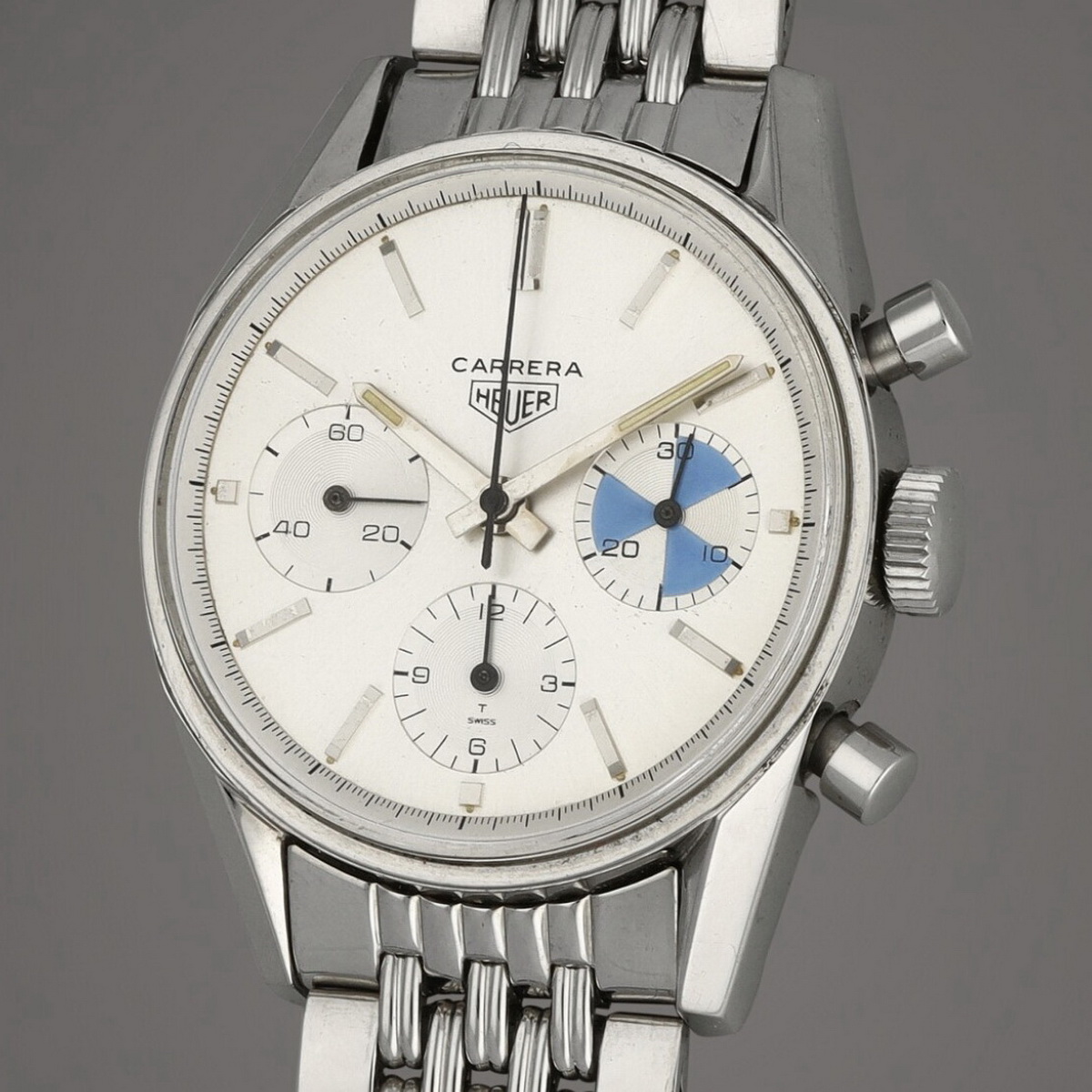
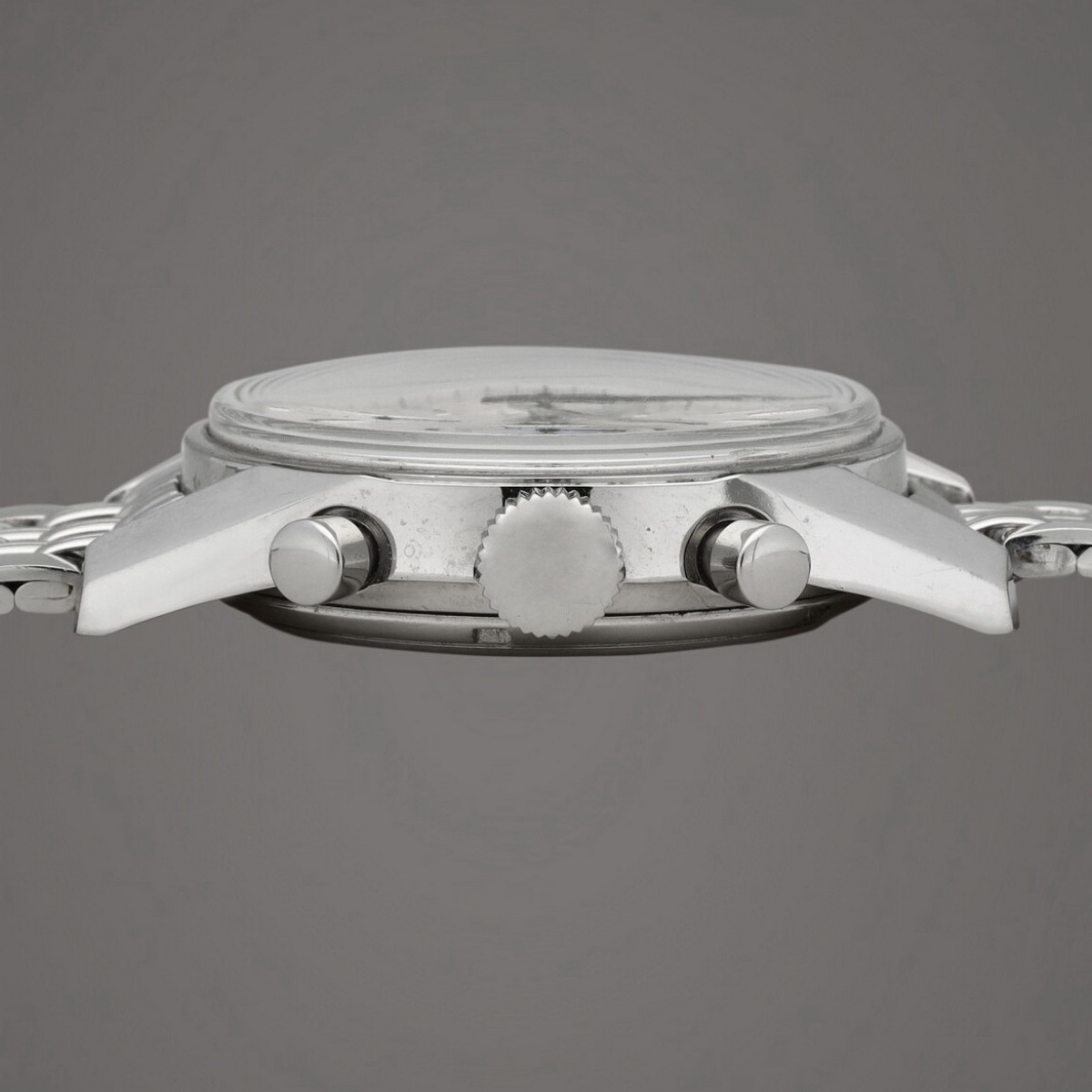
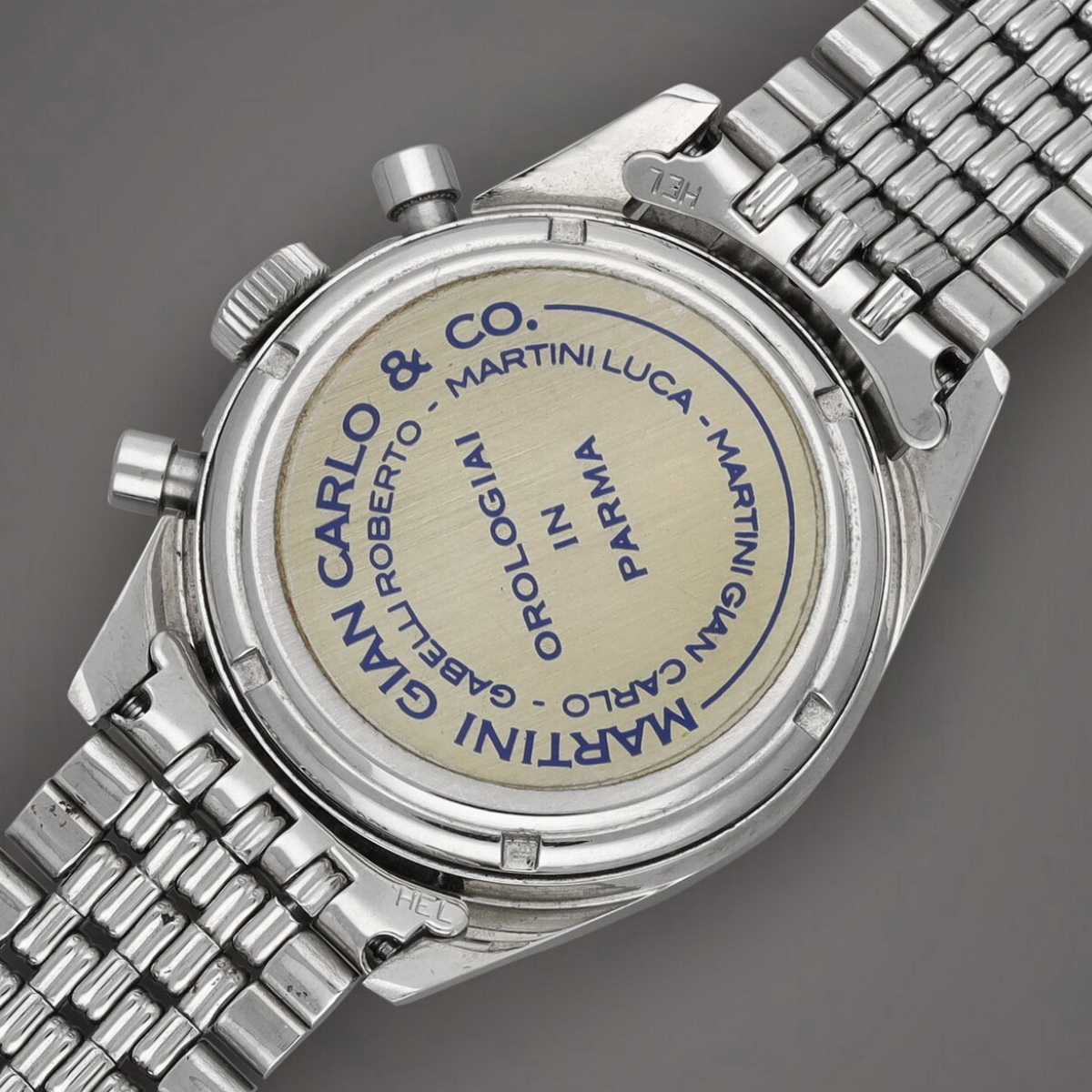
Here is the link to Sotheby’s catalog listing for this watch. The OnTheDash Gallery for the Yachting Carreras is HERE.
Carrera, Three Register Panda – Ref 2447 SND (1968) — Lot 4
With the introduction of the second generation of the Carrera, circa 1968, Heuer went from offering Carrera chronographs with registers always matching the color of the dial to chronographs which offered the customer the choice of contrasting registers – black registers on the white dials and white registers on the black dials. The primary choices were the “SN” (white dial with black registers, also called a “Panda” dial) and “NS” (black dial with white registers, also called a “Reverse Panda” dial). As with the first generation Carrera chronographs, Heuer also offered models with scales printed on the dial –tachymeter (T), decimal minutes (D) and pulsations (P).
Lot 4 being offered by Sotheby’s is a three-register Carrera, with a “Panda” dial and a decimal minutes scale printed on the dial. Rally instructions are generally provided in “decimal minutes”, rather than seconds, as it is easier to perform mathematical operations using decimal minutes than it is using seconds. Consider, for example, the how much easier it is to divide 5.61 minutes by three (1.87 minutes minutes) compared with difficulty of dividing 5 minutes, 36 seconds by three (1 minute, 52 seconds). For this same reason, decimal minutes are also used to express the time in industrial and scientific applications
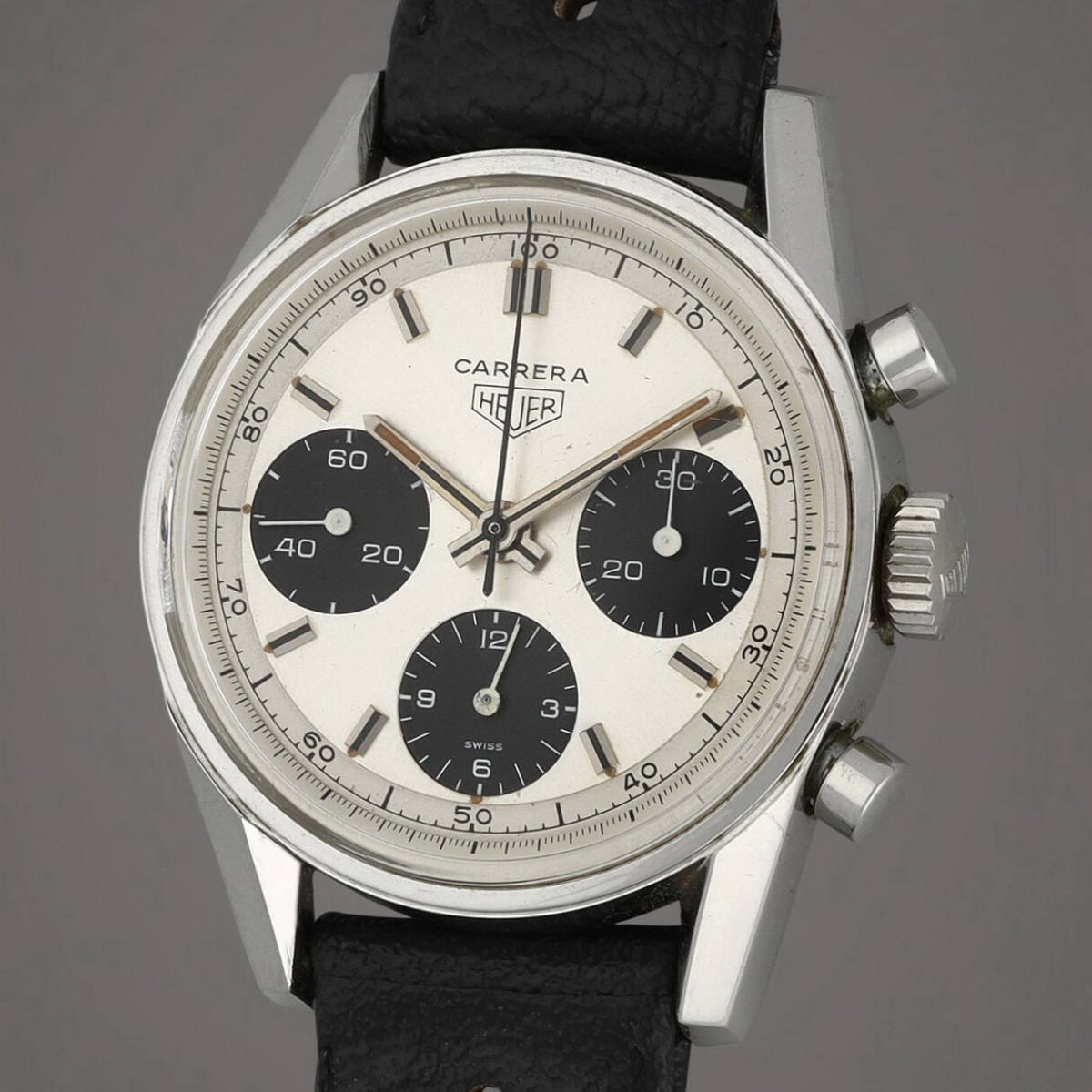
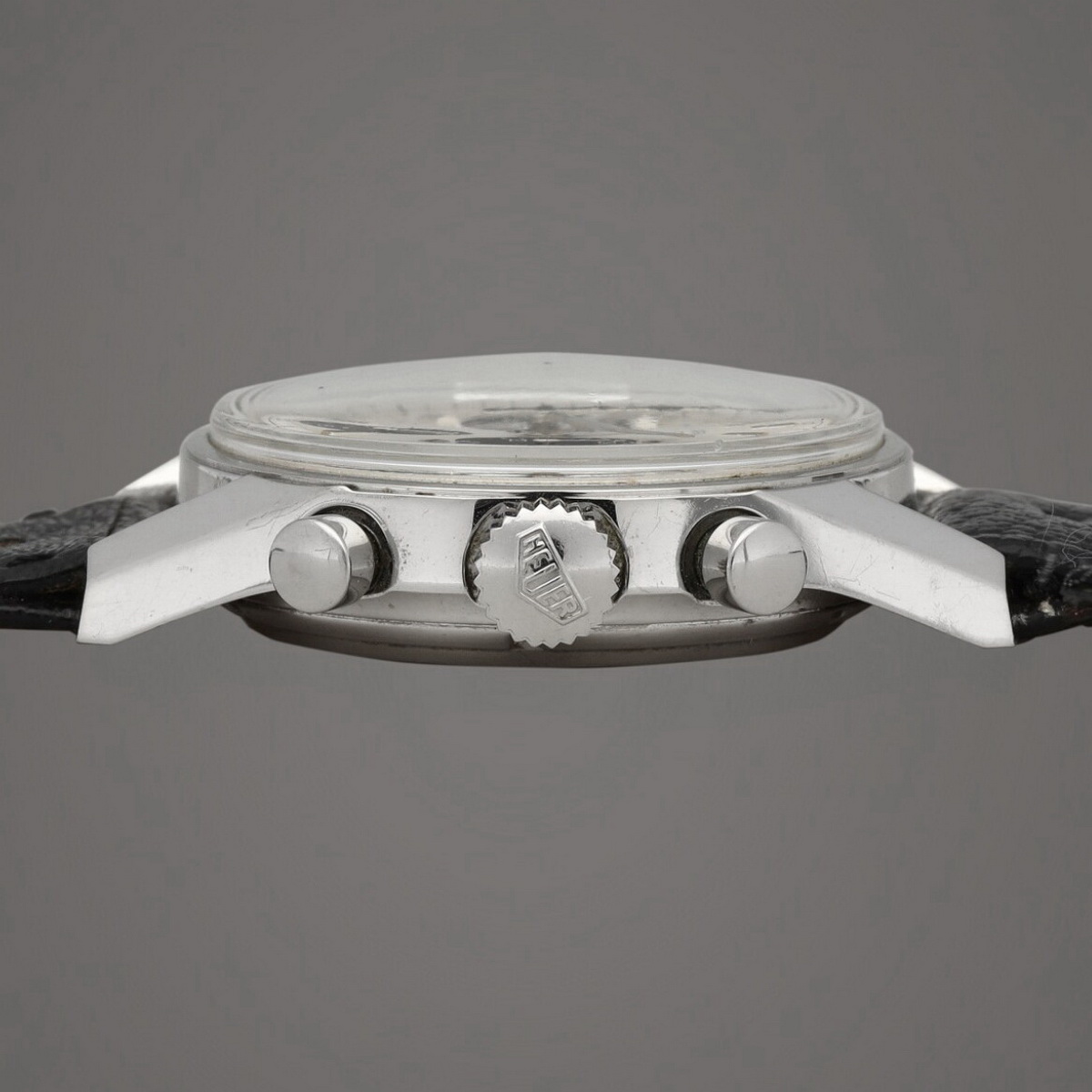
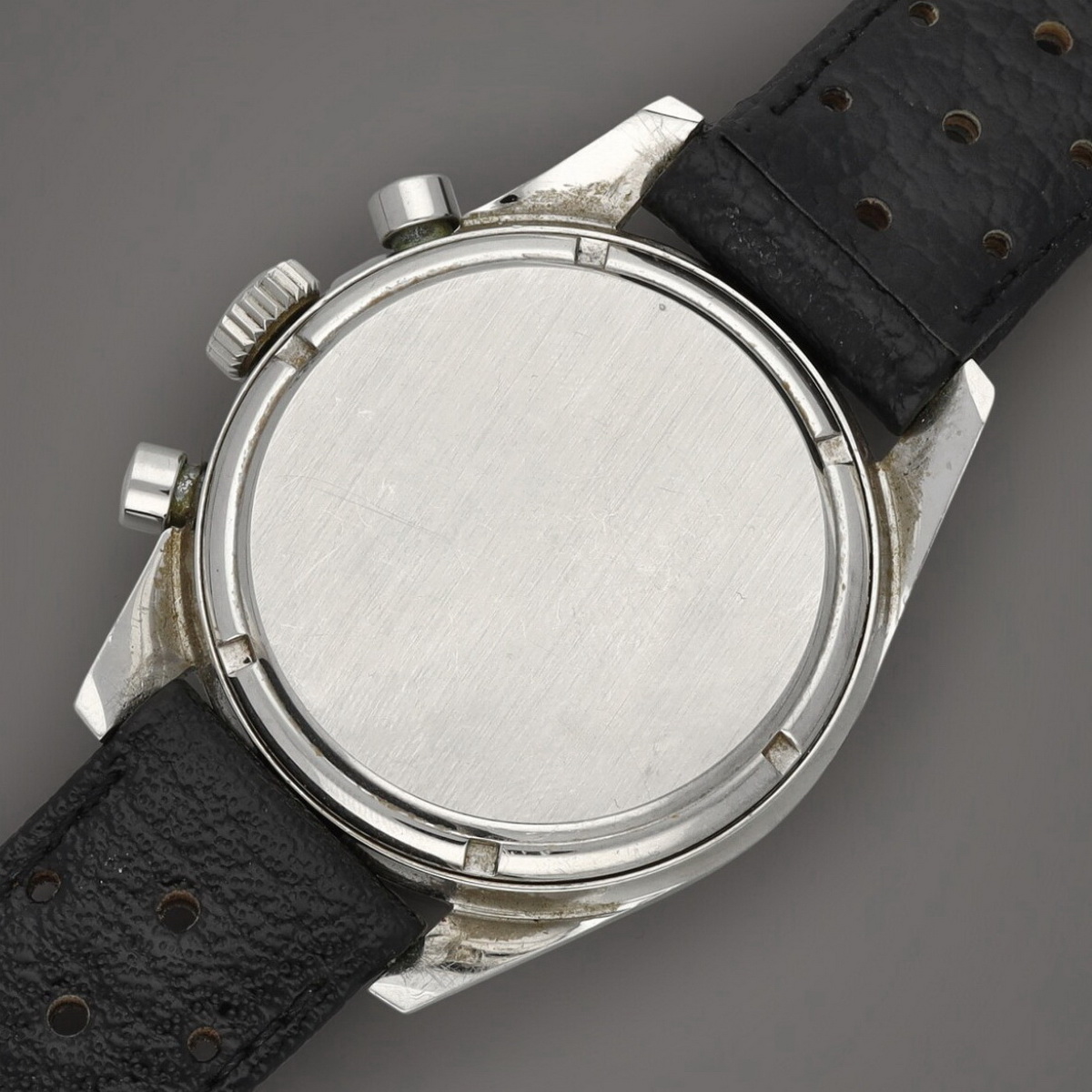
Here is the link to Sotheby’s catalog listing for this watch. The OnTheDash Gallery for the Carrera Reference 2447 SND is HERE.
Autavia “Jo Siffert” Chronomatic, Ref 1163 T (1969) — Lot 6
During the 1950s and into the 1960s, the manual-winding chronographs produced by the leading Swiss brands faced competition from a different category of timepieces, as automatic (self-winding) watches became more popular. The traditional manual-winding chronograph movements from Valjoux, Venus, Lemania and Universal Geneve may also have been getting a bit “tired” by the mid-1960s, as many of these movements (and their predecessors) had been used since the 1930s and 40s. In the mid-1960s, Heuer initiated a joint venture – with Breitling, Hamilton-Buren and Dubois Depraz – that would develop the first automatic chronographs to be available in retail channels around the world. Heuer and Breitling introduced their automatic chronographs in March 1969 and began selling them during the Summer, months before the Zenith El Primero was sold in stores.
Initially, Heuer introduced five models of automatic chronographs — two Autavias (one with a black dial and one with a white dial); two Carreras (one in a stainless steel case and one in an 18 karat gold case); and one version of the Monaco (with a midnight blue dial). These first automatic chronographs were marked “Chronomatic” (an abbreviation for “chronograph automatic”) at the top of the dial, above the Heuer shield, with the model name – Autavia, Carrera or Monaco – printed across the bottom of the dial.
Heuer quickly discontinued the use of the “Chronomatic” name, however, as customers in the United States — Heuer’s largest market — didn’t understand the name “Chronomatic” as indicating that the watch was an automatic chronograph. Accordingly, the standard production models had the model name (Autavia, Carrera or Monaco) printed across the top of the dial, above the Heuer shield, with “Automatic Chronograph” printed across the bottom of the dial. Breitling continued to use the name “Chronomatic” on its automatic chronographs, perhaps evidence of the two brands focusing on different geographic markets.
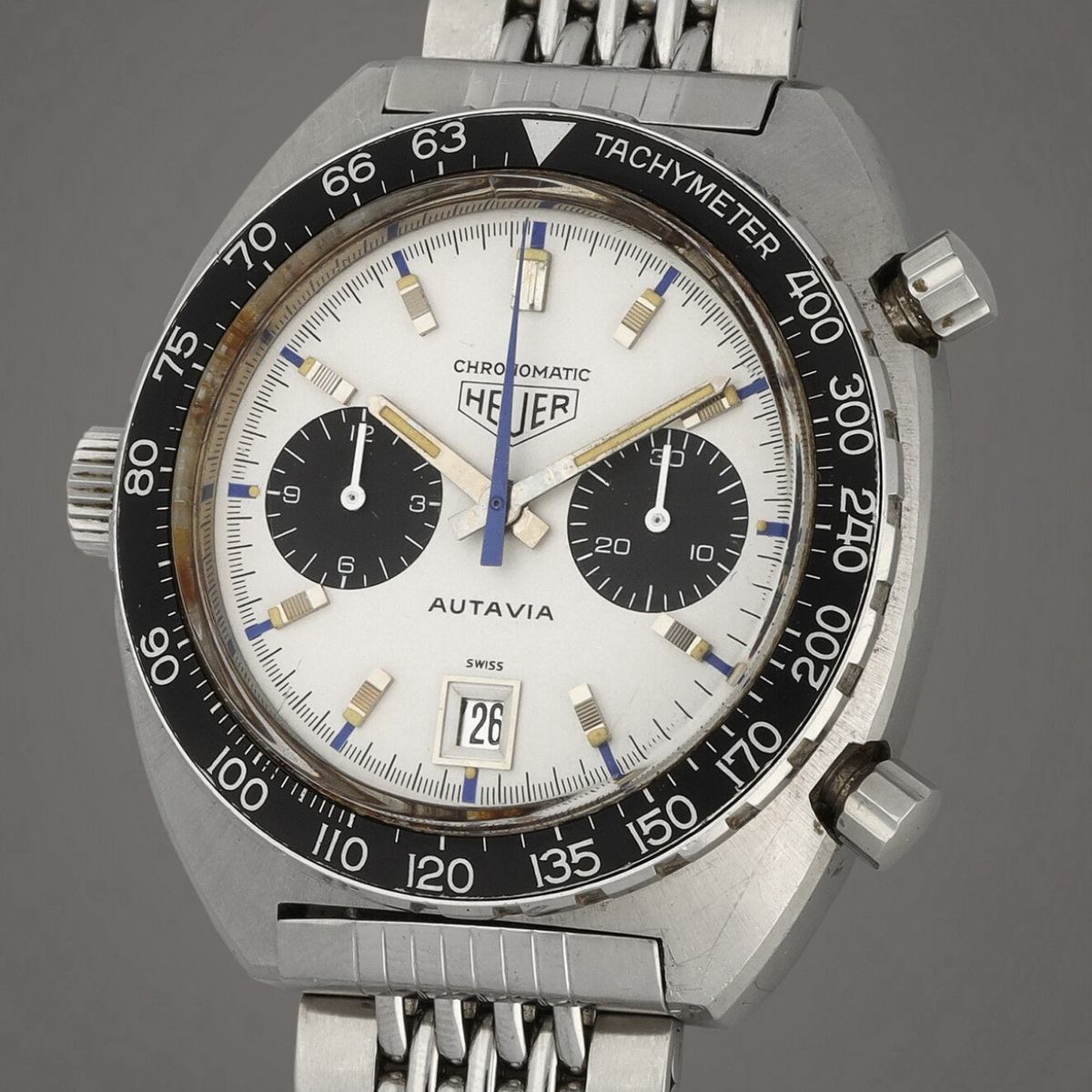
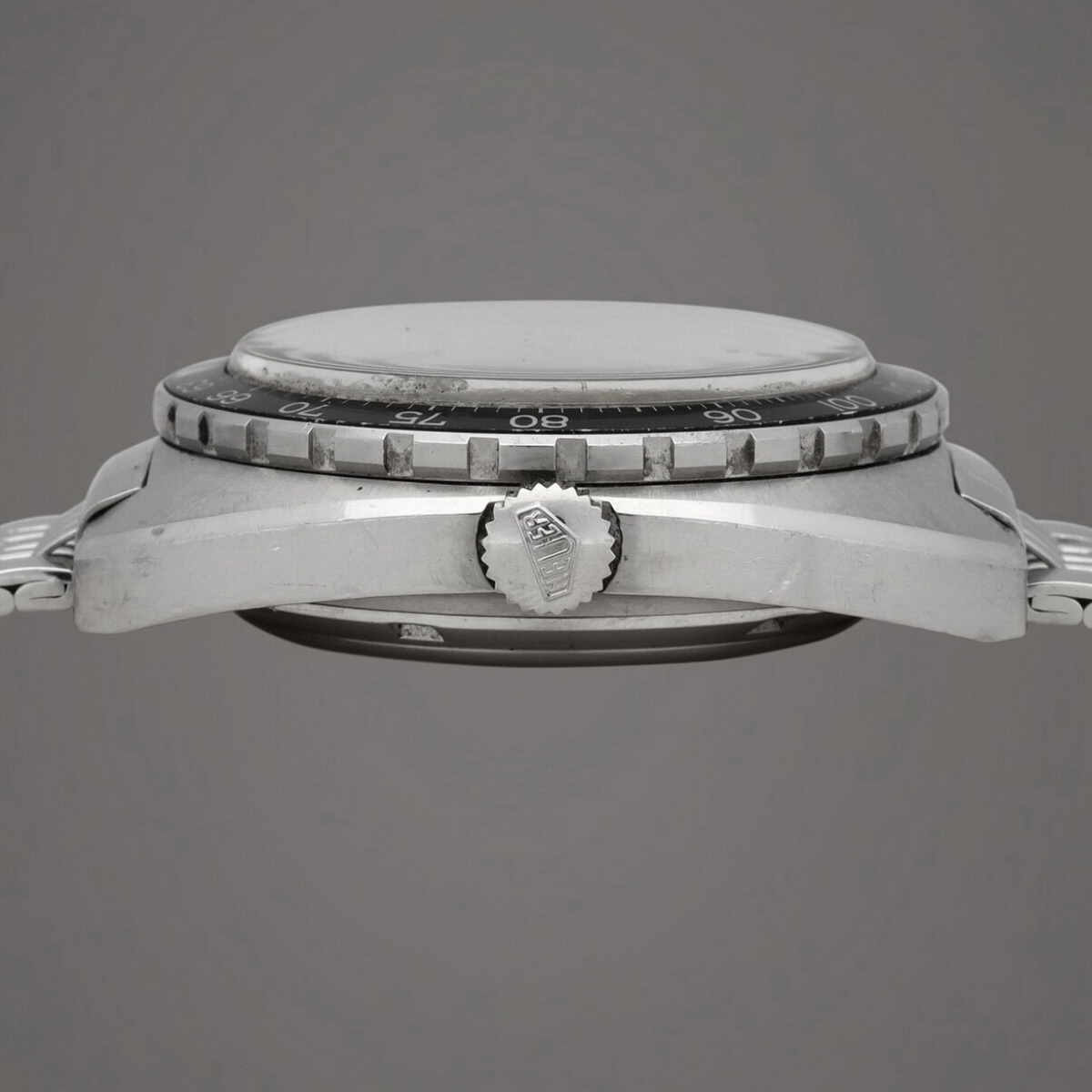
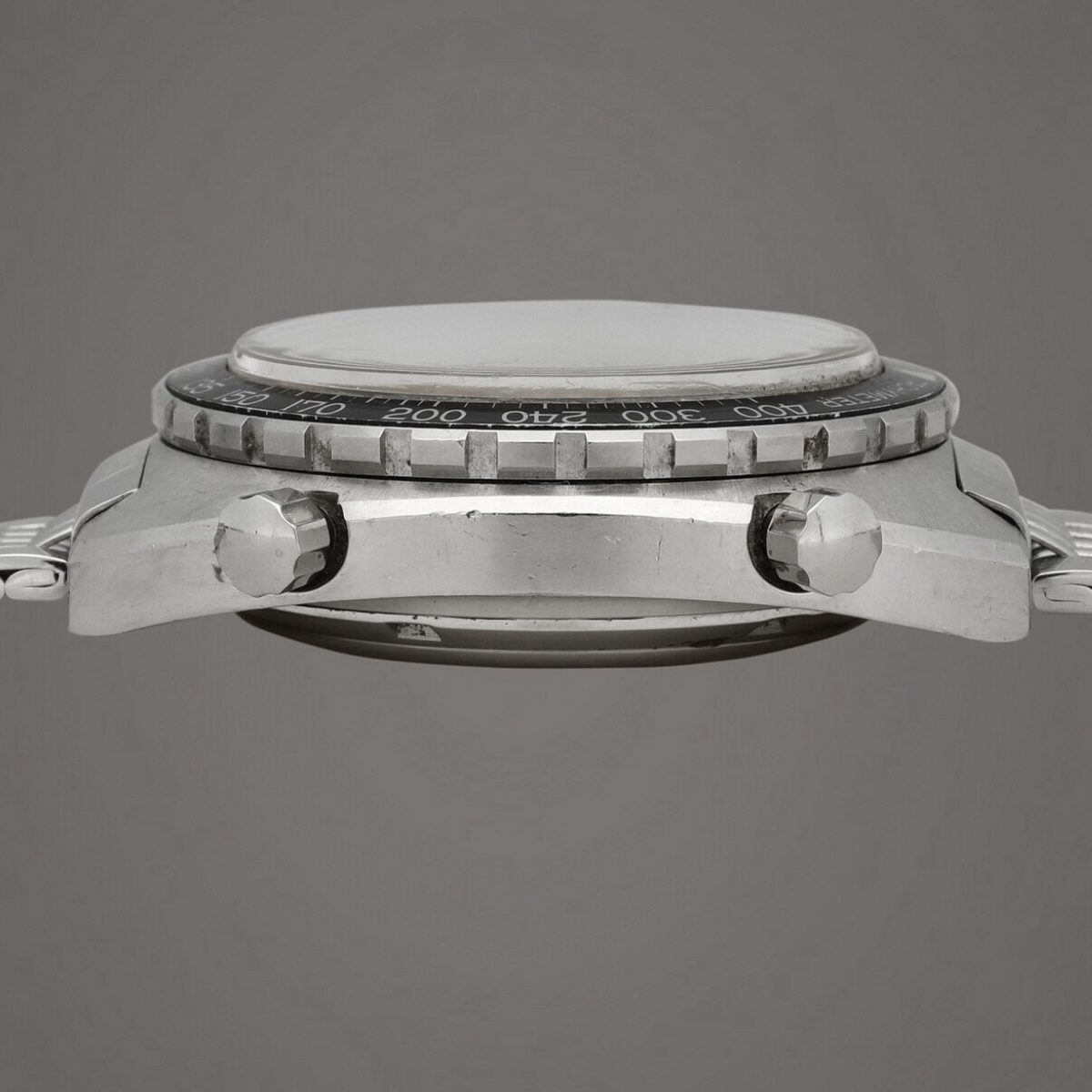
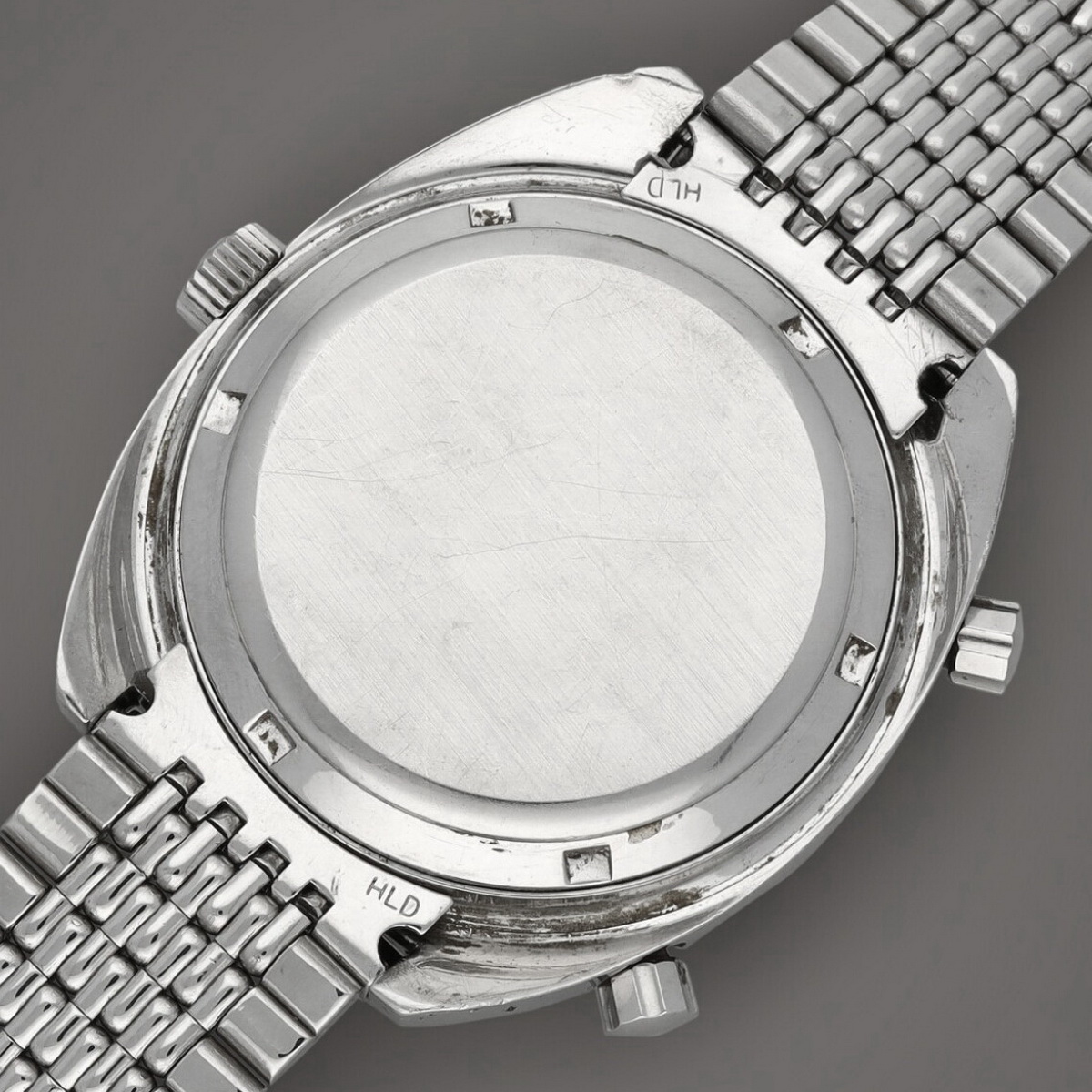
For vintage Heuer enthusiasts, the name “Chronomatic” stirs immediate interest. “Chronomatic” printed on the dial of any Autavia, Carrera or Monaco tells the collector that this was one of the very first automatic chronographs produced by Heuer, and the total number of “Chronomatic” Autavias, Carreras and Monacos produced by Heuer is likely under 500.
The “Chronomatic” Autavia being sold by Sotheby’s as Lot 6 in the May 14 Geneva auction is the reference 1163 T (Tachymeter). Collectors refer to this model as the “Jo Siffert” Autavia, as the version with the white dial, black registers and blue accents, with the Tachymeter scale on the bezel, was regularly worn by Siffert, the Swiss Formula One and endurance racing hero. Jo Siffert was the first Formula One racer to have the Heuer shield on his car; the Heuer “Chronomatic” patch on his racing suit inspired Steve McQueen when he selected the suit, patch and a Heuer Monaco to wear in the filming of Le Mans.
Here is the link to Sotheby’s catalog listing for this watch. The OnTheDash Gallery for the Chronomatic Autavia, Ref 1163T is HERE.
Carrera 18 Karat Gold Automatic, Ref 1158 (1969 to 1985) — Lot 5
Over the decades from the 1930s through the 1960s, Heuer produced relatively few solid gold chronographs (14 karat or 18 karat). With the chronograph being seen as a “tool watch”, often to be used for motorsports, aviation and sailing, as well as scientific and industrial applications, we can understand that stainless steel was the preferred material.
All this changed when Heuer introduced its first automatic chronographs in 1969. The C-shape case used for the automatic Carreras (reference 1153) offered an excellent design for an 18 karat gold chronograph, and it is possible that Heuer’s production of the 18 karat gold automatic Carreras (reference 1158) exceeded its output of all previous 18 karat gold models. The first Carrera reference 1158 came circa 1970 and production continued into the early 1980s. Over the years, there were eight different models of the Carrera reference 1158, with dials in silver or champagne, with contrasting black registers offered with the champagne dial.
In 1970s, Heuer entered into a joint venture with Scuderia Ferrari, under which Heuer would provide the team with race and practice timing and also contribute toward the drivers’ salaries. As part of this arrangement, the Formula One Ferraris would carry the Heuer decal, the drivers wore the Heuer patch on their racing suits and Jack Heuer presented each Ferrari driver with one of these 18 karat gold Carreras. We see Mario Andretti, Jacky Ickx, Niki Lauda, Clay Regazzoni, Jody Schekter and Gilles Villeneuve wearing the big gold Carreras, as well as various team owners and managers. And don’t forget the “friends” of Jack who also wore them, racers who included Jo Siffert, Ronnie Peterson, Mike Hailwood, James Hunt and Emerson Fittipaldi.
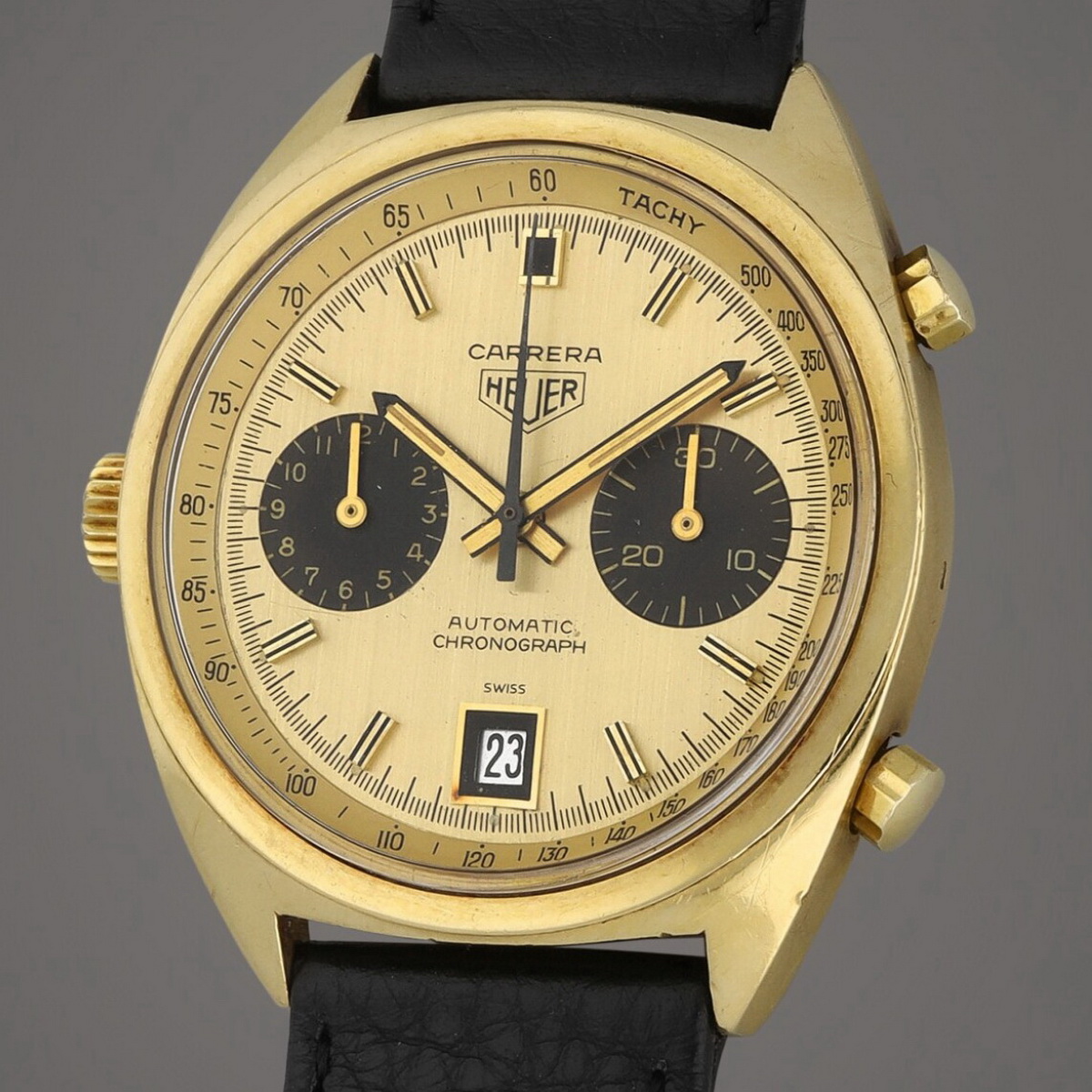
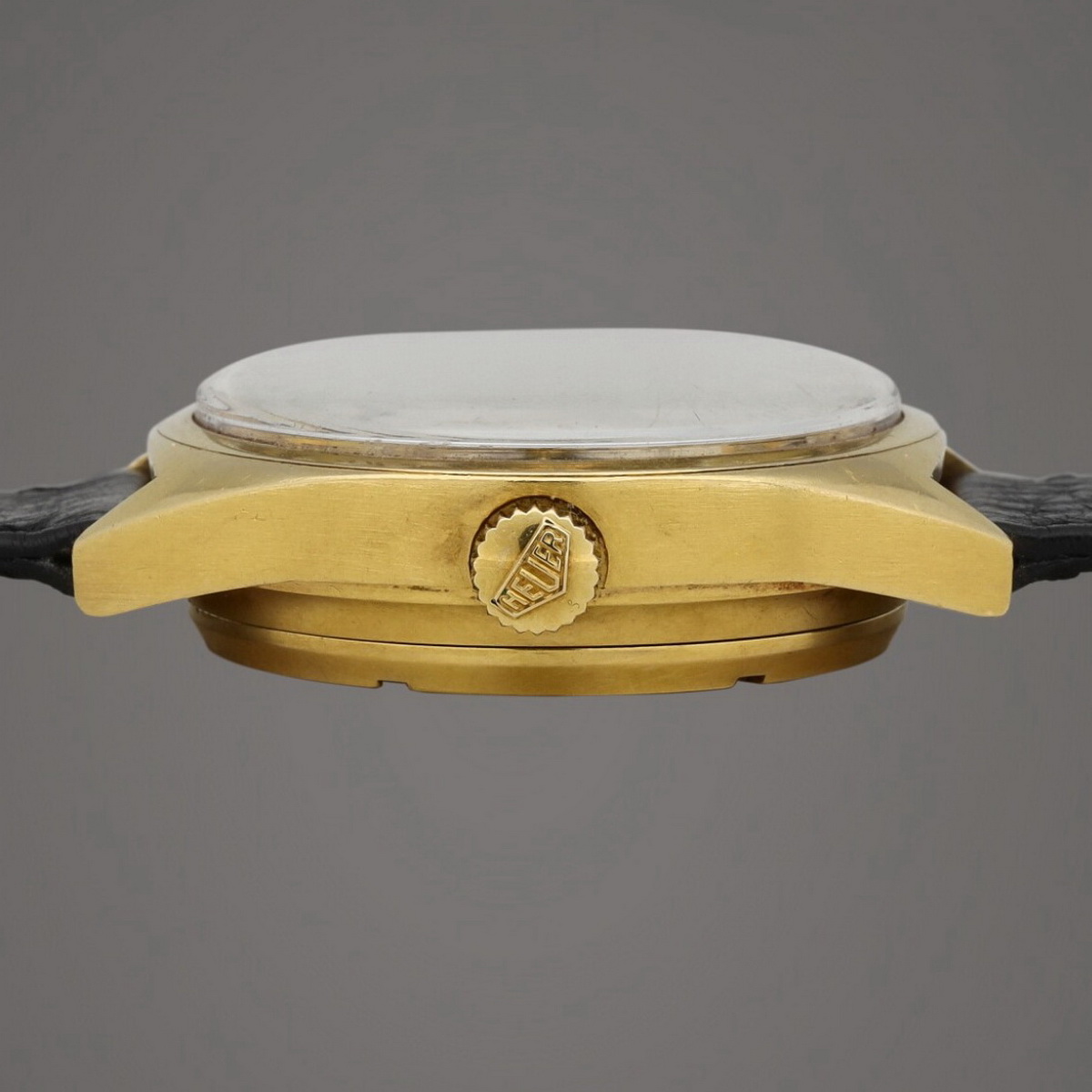
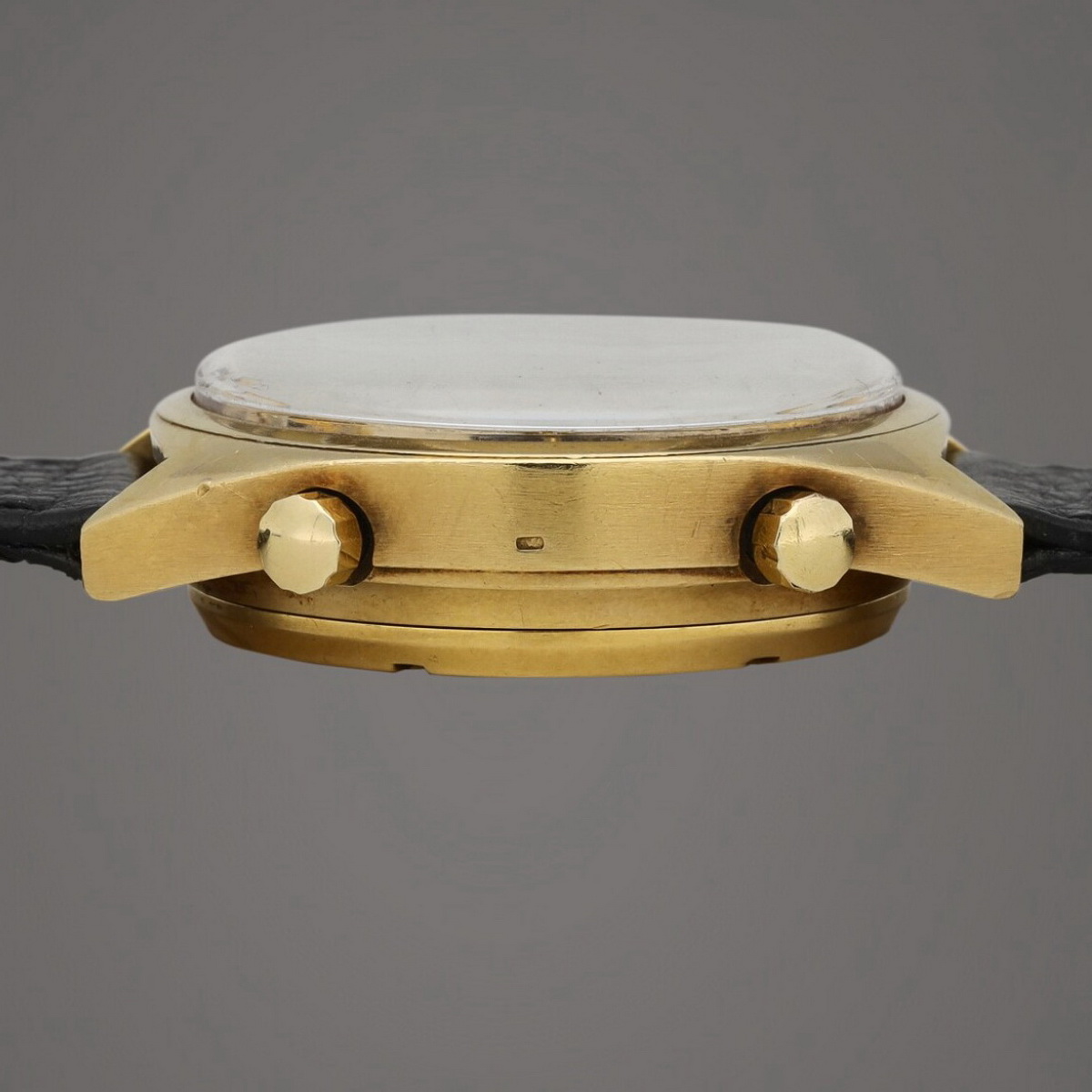
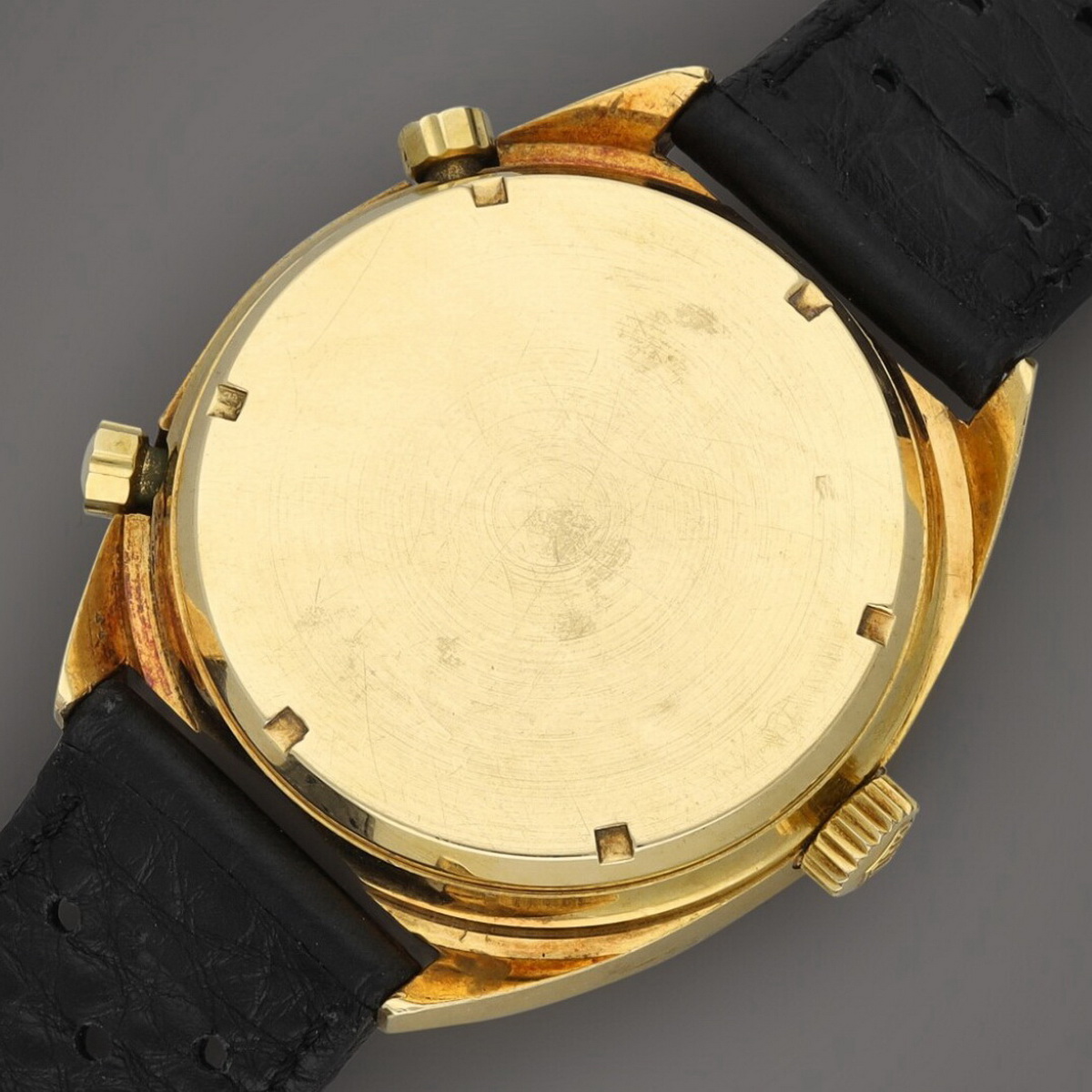
The case of the Carrera reference 1158 weighed 48 grams and the Milanese mesh bracelet — available as a special order item — added another 73 grams, for a total weight of 121 grams. In May 1976, the watch (alone) was listed in the Heuer catalog for $1,279, with the bracelet available for an additional $2,850. So the 18 karat gold Carrera watch and bracelet sold for over $4,000, at a time when the Swiss brands were struggling to sell their watches. By contrast, the price of a standard issue Autavia was in the $450 range and, in March 1975, Heuer was selling close-out versions of the Monaco for $93.50. Yes, the 18 karat gold Carreras were high-priced watches!
In the vintage Heuer community, the most coveted versions of the Reference 1158 Carrera are the models with a champagne dial and black registers (Reference 1158 CHN). The first execution of this model has a black date disc (with white numerals) and the second execution has a white date disc (with black numerals). Lot 5 being sold by Sotheby’s is a second execution model.
Here is the link to Sotheby’s catalog listing for this watch. The OnTheDash Gallery for this version of the Carrera Reference 1158 CHN is HERE.
For additional information about Reference 1158 Gold Carreras, see the OnTheDash posting — The Definitive Guide to the 18 Karat Gold Carrera (Reference 1158). You can see all the versions of the Reference 1158 Carrera HERE.
Monaco in Black-Coated Case, Ref 74033N (the “Dark Lord”) (1975) — Lot 7
When Heuer introduced its first automatic chronographs in 1969, the Autavia and Carrera chronographs were redesigned so that their cases could house the new Calibre 11 movement, but these two collections followed the lines of chronographs being produced in this era. In addition to the Autavia and Carrera, Heuer celebrated its development of the automatic chronograph with an entirely new model, the Monaco. Offered with a choice of midnight blue or gray dials, the Monaco was a radically new style of watch. It was the first waterproof chronograph offered in a square case, with the case using a unique construction, the top of the case being held to the case-back by hidden internal clips.
Heuer struggled to sell the Monaco chronographs, from the time they were introduced. Perhaps the design of the Monaco was too far ahead of popular preferences. Even if the Monaco had been popular with customers, exchange rates for the Swiss franc and the availability of far less expensive watches from Japan would have made the radically-styled chronograph difficult to sell. But by the mid-1970s, when Heuer was offering various models of the Monaco on a close-out basis (for $93.50), a new style of chronograph was proving to be popular. Porsche Design had introduced a black-coated, tactical style chronograph in 1972, other Swiss brands jumped in on the trend, and in 1976 Heuer introduced its first black-coated chronograph, the Monza.
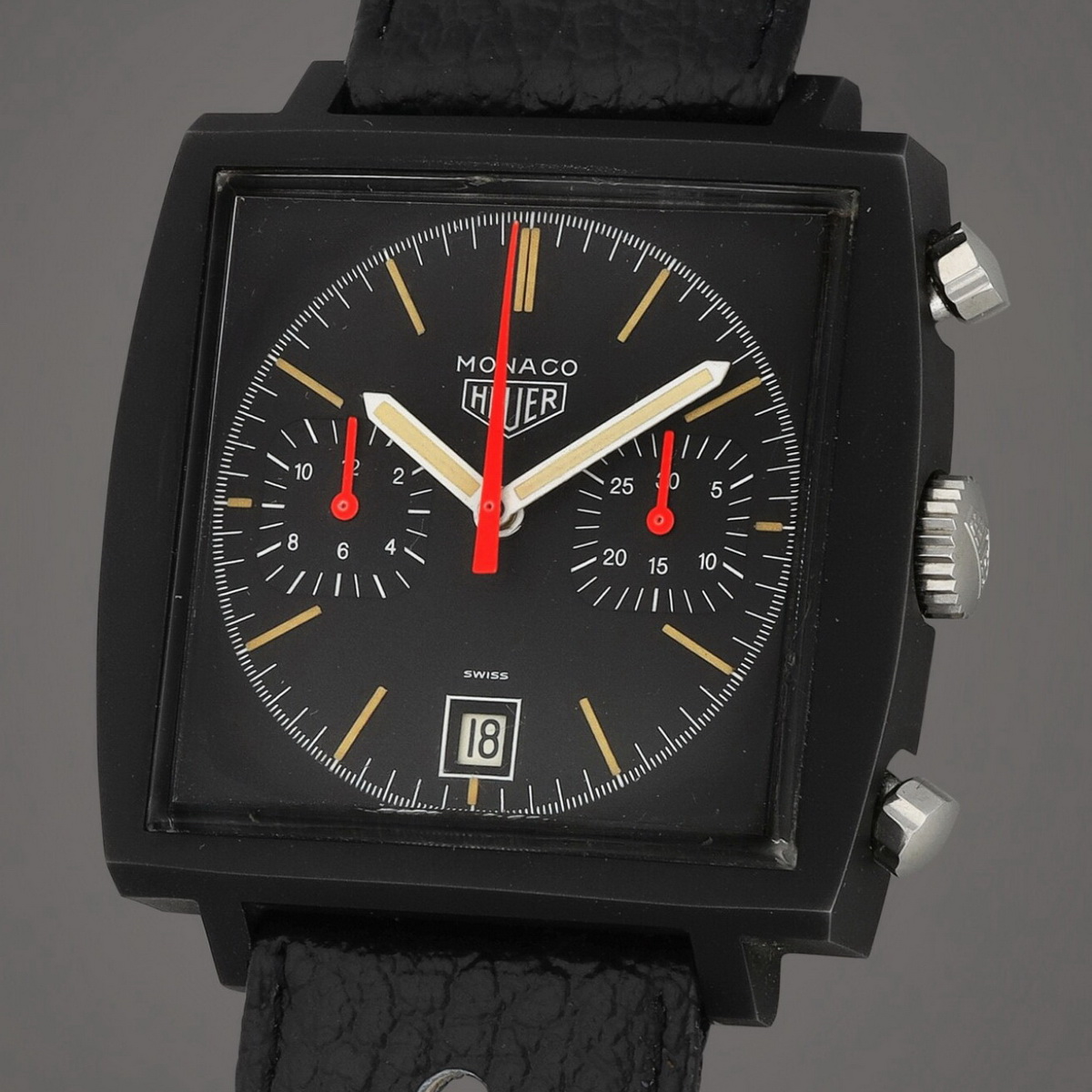
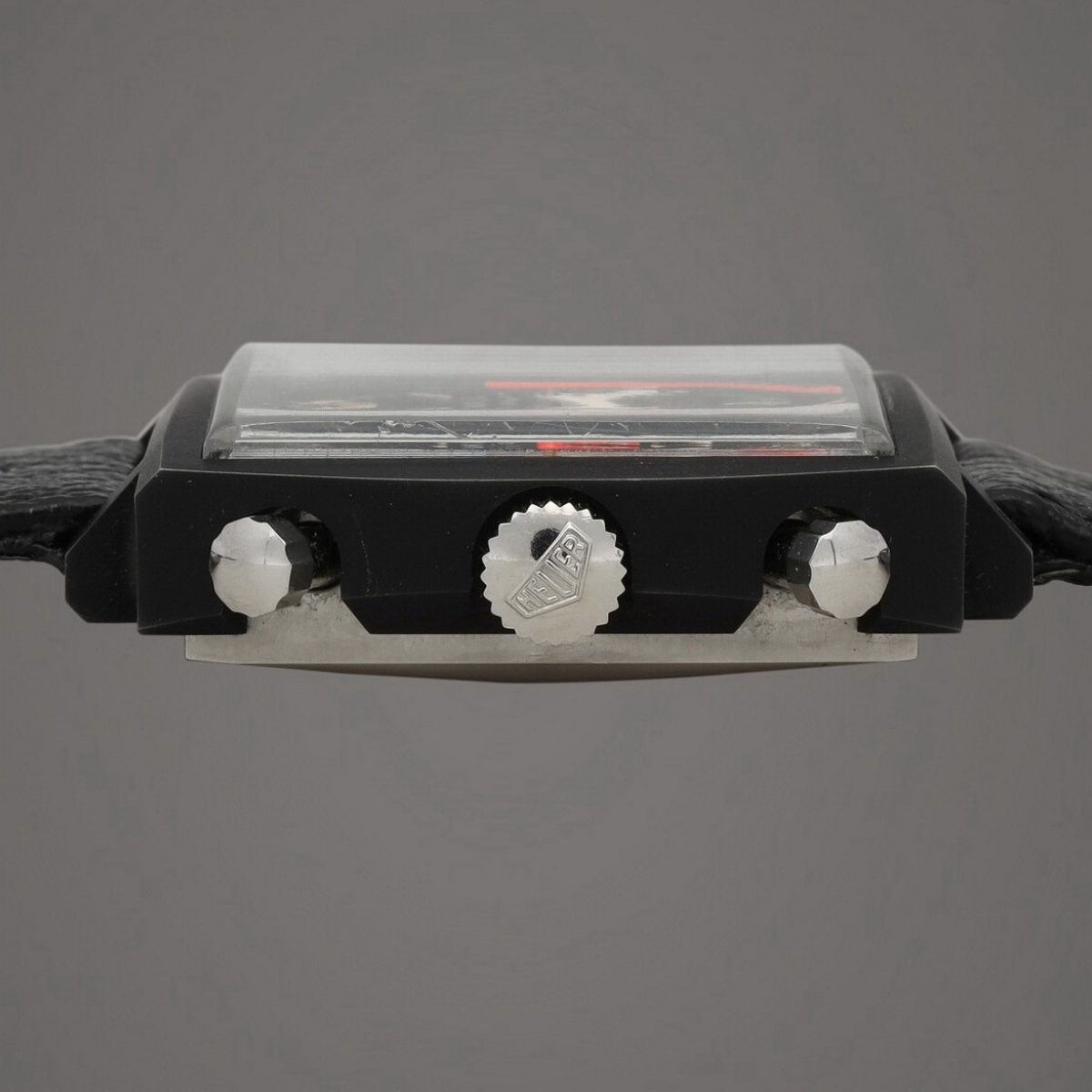
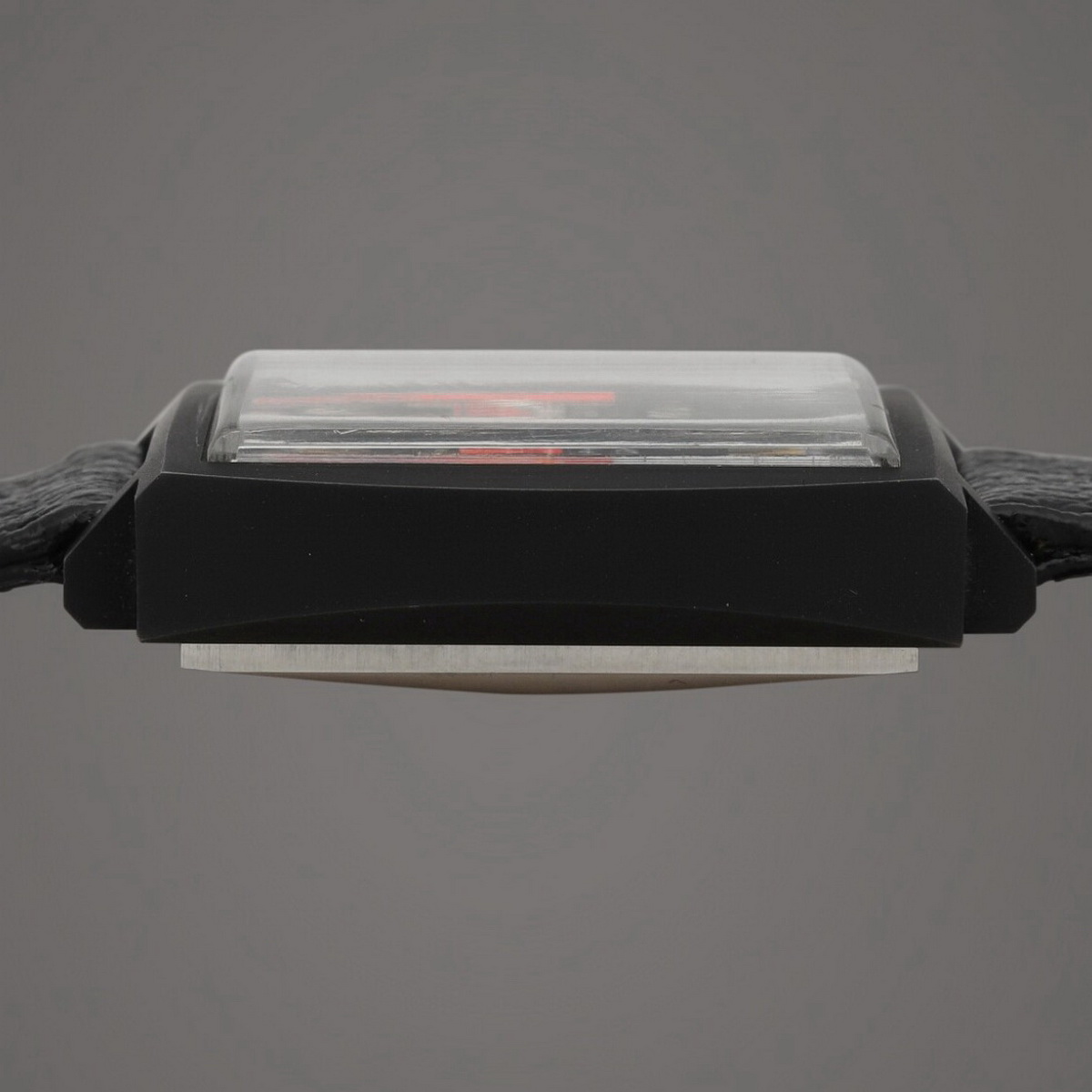
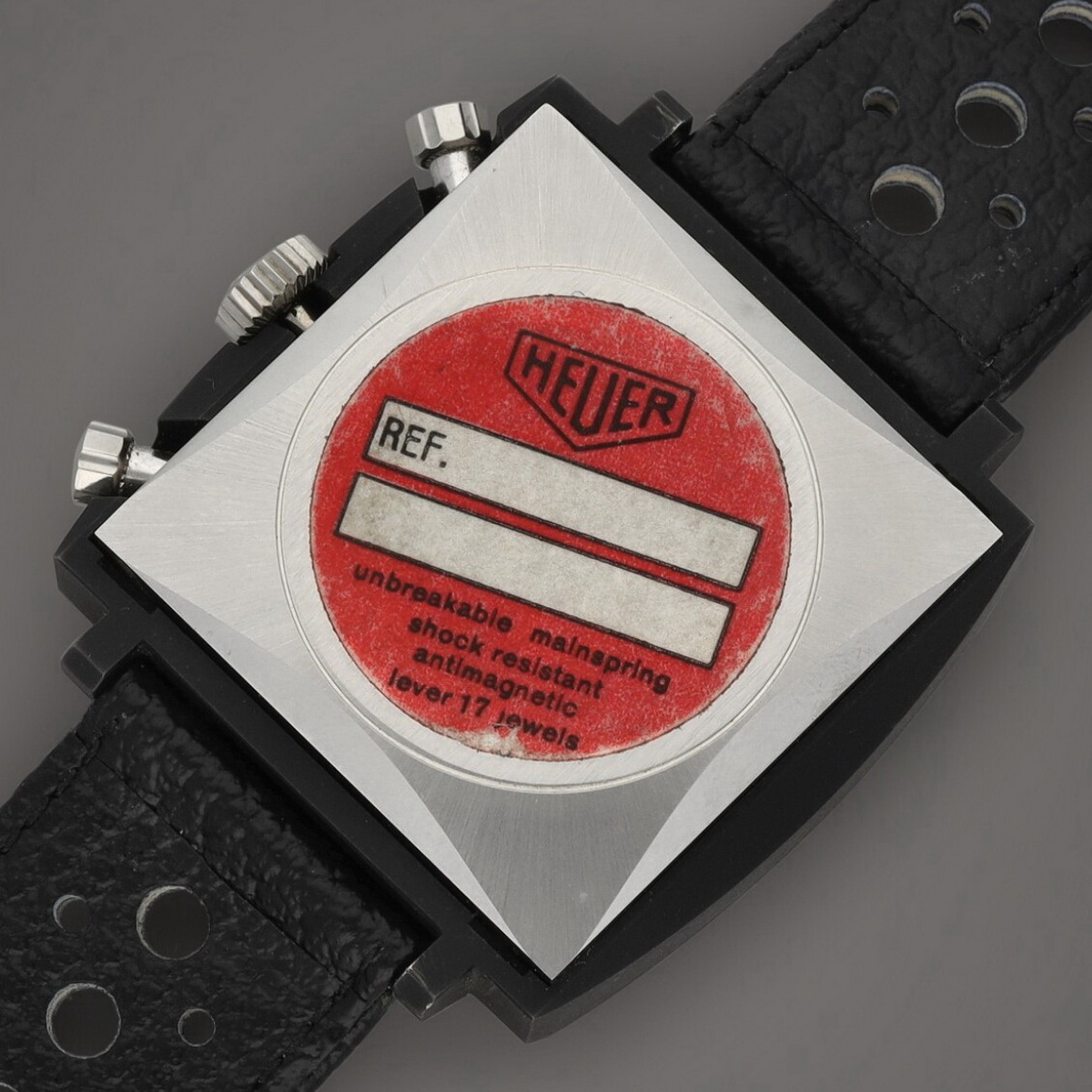
In what appears to have been a last-ditch to develop a Monaco that would find success, circa 1977 Heuer took one of its stainless steel Monaco cases (reference 74033), applied black coating, and created a dial and hands that suited the dramatic new style of what would come to be known as the “Dark Lord” Monaco chronograph. The dial was all black, with long, thin painted luminous markers; the main time-of-day hands were bright white; the chronograph hands (hours, minutes and seconds) were an ultra-bright orange.
Still, the black-coated Monaco would not be the savior that Heuer was hoping for. The model never went into full production, the usual explanation being that Heuer was unsuccessful in getting the black coating to adhere to the sharp-edges of the case. The Reference 74033 N was never included in a Heuer catalog, and there are mysterious stories of parts and partially-assembled watches appearing in remote corners of the world.
Here is the link to Sotheby’s catalog listing for this watch. Also see the OnTheDash Gallery for the Monaco Reference 74033 N.
For additional information about the Heuer Monaco, Reference 74033 N, see my posting on Hodinkee — The Heuer Black-Coated Monaco Captures The Darkness and Mystery Of The 1970s.
